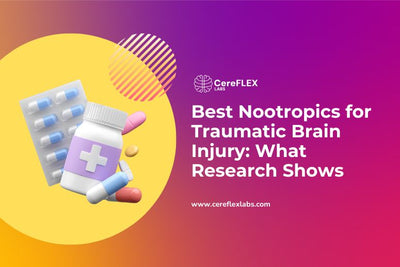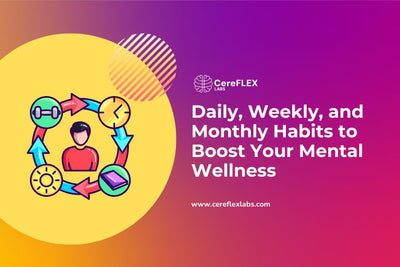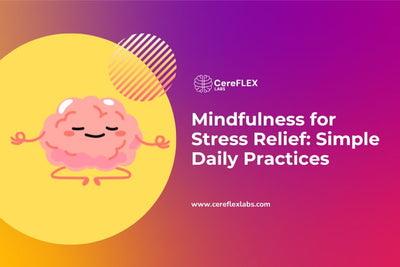When you walk into a health store or scroll through a wellness website, you’ll notice dozens of herbal supplements promising to boost memory, ease stress, or support cognitive health. But here’s the challenge — not all of them are what they seem.
Some supplements contain low-grade ingredients, vague labels, or haven’t been tested for safety. Others are carefully formulated and meet rigorous quality standards. Knowing how to tell the difference can make a real impact on your health.
If you’ve ever stood in the supplement aisle wondering whether a product is worth it, you’re not alone. The good news? There are clear signs that can help you spot a high-quality herbal supplement quickly.
This guide walks you through what to look for — from ingredient labels and certifications to red flags and trusted formats — so you can make confident, informed choices.

What makes a herbal supplement “high-quality”?
Not all herbal supplements are created equal. Unlike prescription medications, herbal products are not subject to the same pre-market approval processes in Canada, which means their quality can vary widely.
A high-quality herbal supplement is one that is safe, consistent, and backed by both science and responsible manufacturing. In Canada, look for a Natural Product Number (NPN) issued by Health Canada. This confirms the product has been reviewed for safety, effectiveness, and proper labelling. You can verify an NPN through Health Canada’s online database.
Other signs of quality include:
Purity and Consistency
Reputable supplements maintain stable levels of active ingredients and avoid harmful contaminants like heavy metals or undisclosed fillers. Look for brands that follow Good Manufacturing Practices (GMP) and invest in third-party testing from groups like NSF International or ConsumerLab.
Evidence-Based Benefits
The best supplements aren’t just based on tradition or marketing hype — they’re supported by clinical studies. Scientific backing ensures you're not wasting money on ineffective products.
Safety and Clear Labelling
Trustworthy supplements disclose exact dosages, potential allergens, drug interaction warnings, and a full list of active and inactive ingredients.
Professional Endorsement
High-quality products are often used or recommended by healthcare practitioners as part of broader wellness or recovery plans.
Whether you’re seeking herbal support for daily wellness, energy, or brain recovery, these standards help you find supplements you can rely on.
Red Flags That Signal Poor Supplement Quality
Not every supplement in the natural health aisle is what it claims to be. Some products may look credible on the surface but hide serious quality issues. Watch for these common red flags:

Hidden Dosages in Proprietary Blends
These blends may sound advanced, but they often hide how much of each ingredient is actually inside. Without dosage transparency, there’s no way to assess whether a product is safe or effective.
Exaggerated Health Claims
Be wary of supplements that claim to “cure” diseases, deliver “instant results,” or fix multiple unrelated issues at once. These types of promises are not only scientifically unsupported — they are also banned by Canadian regulators.
No Supplement Facts Label
Legitimate products always include a clear Supplement Facts label showing ingredients, amounts, usage, and warnings. If this information is missing or vague, skip it.
Missing Natural Product Number (NPN)
Every approved herbal supplement sold in Canada must carry an NPN issued by Health Canada. If a product doesn’t display this number on its packaging or product page, it hasn’t been reviewed for safety — and shouldn’t be trusted.
Check the Supplement Facts Label Like a Pro
Reading supplement labels isn’t just for experts — it’s one of the easiest ways to make smart, safe choices. Here’s how to understand the key parts of a label so you know exactly what you’re getting:

Serving Size and Dosage
This tells you how much of the supplement you’re taking in each serving — whether it’s one capsule, two scoops, or a dropper-full. Check that the ingredient amounts match what’s typically supported by research for your needs.
Active Ingredients
Look for clearly named ingredients with exact quantities. For example: “Ashwagandha extract (root), 500 mg” is better than a vague “herbal blend.” This helps you verify strength and quality.
Daily Values
These percentages show how a supplement fits into your daily intake. While not all herbal ingredients have daily value percentages, the ones that do should be listed clearly.
Other Ingredients
This section lists non-active components like fillers, binders, preservatives, or flavourings. High-quality supplements avoid unnecessary additives and clearly note common allergens such as soy, gluten, or dairy.
Suggested Use
Reliable products will tell you exactly how and when to take them. Vague instructions like “use as needed” may indicate a lack of research behind the dosage.
Expiration Date
Herbal supplements can lose their potency over time. Always check for an expiration date to ensure you’re getting an effective product.
Cautions and Warnings
If you take medication or have health conditions, this section matters. Look for potential interactions, usage restrictions for pregnancy or medical conditions, and general safety warnings.
Certifications and Quality Seals
Look for third-party verifications like Certified Organic, Non-GMO, or — in Canada — the Natural Product Number (NPN). These markings confirm the product meets standards for safety and quality.
Choose Sustainably Sourced, Organically Grown Ingredients
When it comes to herbal supplements, where the ingredients come from — and how they’re handled — matters just as much as what’s listed on the label.
Know the Source
Look for supplements made from herbs that are organically grown, wildcrafted, or responsibly harvested. These practices reduce your exposure to pesticides, heavy metals, and other contaminants often found in poorly regulated imports.
Trustworthy brands are upfront about where their organic ingredients are sourced — for example, “organic ashwagandha root from India.” They may also indicate whether they use full-spectrum extracts or standardized compounds, both of which affect potency and consistency.

Look for Ingredient Transparency
Reliable brands provide clear details about how each ingredient is grown, processed, and tested — either on the product label or their website. Avoid vague terms like “natural” or “plant-based” without further explanation.
Being transparent helps build trust and allows you to make more informed choices.
Special Considerations: Adaptogens and Brain-Support Herbs
If you’re choosing herbal supplements to improve focus, reduce stress, or support memory, ingredient quality becomes even more important.
Popular adaptogens like ashwagandha, rhodiola, and ginseng are commonly used in brain and energy formulas — but their effectiveness can vary widely depending on how and where they’re grown.
Poor sourcing or improper processing may weaken their benefits or even cause unwanted effects. That’s why it’s worth looking for standardized extracts, which ensure each dose delivers consistent active compounds.
Also, check for purity testing or certification seals that confirm these ingredients are free from contaminants. For those managing recovery, working through mental fatigue, or just aiming for clearer thinking, the right source can make a noticeable difference.
CereFLEX Labs AM/PM Protocol: A Real-World Example of Transparency
Understanding where your supplements come from — and how they’re made — builds trust. The CereFLEX Labs AM/PM Protocol offers a helpful example of what ingredient transparency and manufacturing standards can look like in practice.
Here’s how it stands out:
✔ Full Ingredient Disclosure: The AM and PM formulas list each ingredient in exact amounts, including cognitive-supporting herbs like ashwagandha, rhodiola, and ginkgo biloba — no vague “blends” or hidden fillers.
✔ Health Canada Approval: Both formulas are registered with Natural Product Numbers (NPNs), confirming they've been reviewed and approved by Health Canada for safety, efficacy, and labelling accuracy.
✔ GMP-Certified Manufacturing: CereFLEX products are made in facilities that follow Good Manufacturing Practices, helping ensure consistency and quality in every batch.
✔ Third-Party Testing: Each product is independently tested for potency and purity, which helps confirm that what’s on the label is exactly what you’re getting.
For anyone prioritizing ingredient sourcing and transparency, CereFLEX Labs provides a practical benchmark for what quality looks like in the herbal supplement space.
Choose the Right Supplement Form
Not all herbal supplements come in the same form — and the one you choose can affect how well it works for you. The most common formats are capsules, powders, and tinctures. Each has its own strengths depending on your preferences, lifestyle, and health goals.
Here’s a quick comparison:
Comparing Herbal Supplement Formats |
|||||
|---|---|---|---|---|---|
|
Form |
How Fast It Works |
Ease of Use |
Taste |
Dose Control |
Best for… |
|
Capsules |
Moderate (Standard Digestion) |
Very Easy — Just Swallow |
No Taste (Encased) |
No — Fixed Per Capsule |
Simple, Portable Option With No Prep |
|
Powders |
Fast — Especially With Food |
Medium — Requires Mixing |
Strong or Earthy Taste |
Yes — You Control the Amount |
Flexibility to Add to Smoothies or Shakes |
|
Tinctures |
Fastest — Absorbed Quickly |
Medium — Dropper or Mix |
Strong Herbal Taste |
ome — Measured in Drops |
Quick Results and Adjustable Dosing |
Capsules or Tinctures: Which Is Better?
The best format depends on your needs:
- Tinctures are absorbed more quickly since they bypass digestion. They're ideal for fast-acting herbs like valerian or passionflower, and they allow for flexible dosing.
-
Capsules are tasteless and easy to take on the go, making them great for daily, long-term use. However, they can take longer to digest and may not suit people with digestive issues.
Ultimately, it's about finding what works best for your routine and health goals.
Research the Brand: Reputation & Reviews Matter
Even the best-looking label can’t make up for a poor-quality product. Before buying any herbal supplement, take a moment to learn about the company behind it.
Look for Transparency
Trustworthy brands explain where their herbs come from, how they’re processed, and what steps are taken to ensure quality. This includes ingredient sourcing, testing methods, and manufacturing practices.
If that information isn’t available — or if the company avoids specific questions about safety or sourcing — that’s a red flag.
Independent Testing Matters
Good brands don’t just say their products are pure — they prove it. Third-party testing for potency and contaminants, like heavy metals or microbial risks, helps confirm the product matches what’s on the label.
Read Real Reviews
Customer reviews and testimonials give insight into how the supplement works in real life. Look for patterns — consistent complaints about side effects, lack of results, or packaging issues are worth noting.
It’s also a good sign if the company backs its products with clinical data or links to published research. That shows a commitment to science, not just sales.

Where to Buy Herbal Supplements Safely
Choosing where to buy your supplements is just as important as choosing what to buy. In Canada, these four sources are generally considered the most reliable:
1. Licensed Pharmacies
Pharmacies regulated by provincial health authorities carry supplements approved by Health Canada. Pharmacists can also help you check for potential interactions with other medications or health conditions.
2. Natural Health Stores
These stores often stock high-quality brands and usually have staff knowledgeable in herbal medicine. They're a solid option for in-person guidance.
3. Direct from Brand Websites
Buying directly from the brand’s official website helps ensure you’re getting the real product. For instance, CereFLEX Labs sells its AM/PM Brain Supplement Package online, with full ingredient details and manufacturing info included.
4. Reputable Online Retailers
Websites like Well.ca and Amazon Canada (only when sold and shipped by Amazon) can be convenient. Just make sure the product shows a valid Natural Product Number (NPN) to confirm Health Canada approval.
Conclusion: Making Smart Supplement Choices
Choosing the right herbal supplement isn’t just about brand popularity — it’s about knowing exactly what you’re putting into your body.
Start by checking for a valid Natural Product Number (NPN), reading the Supplement Facts label carefully, and confirming whether the product has been tested by a reputable third party. Ingredient sourcing, clear dosage information, and certifications like GMP should also be part of your checklist.
If you're looking for a product that meets these standards, the CereFLEX Labs AM/PM Protocol is one example worth exploring. It offers full ingredient disclosure, has received Health Canada approval, and is designed to support brain health during both day and night.
Interested in improving focus, memory, or energy safely? Check out the CereFLEX AM/PM Brain Supplement Package and take your next step toward better brain performance.






